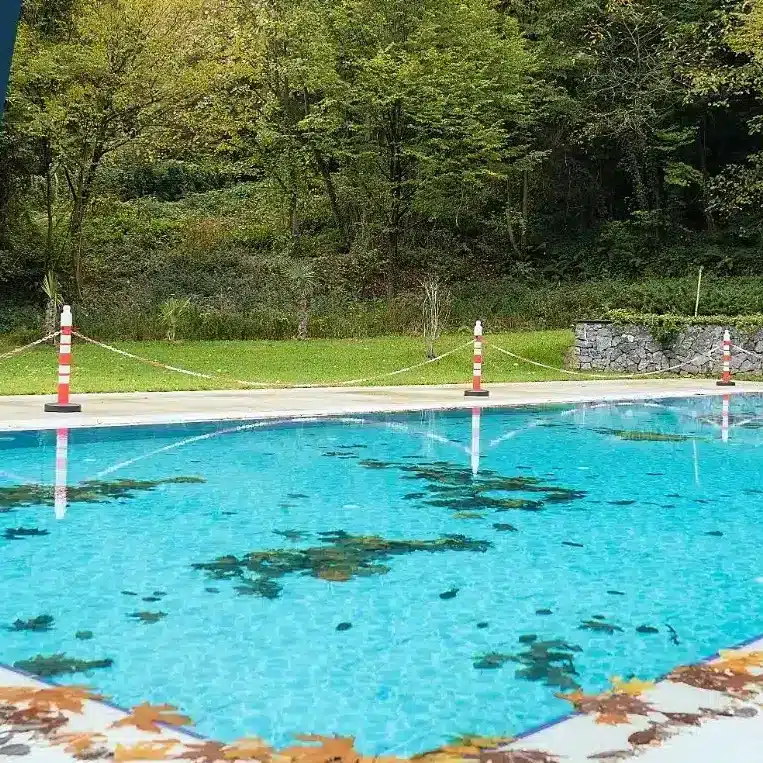Free delivery, French manufacturing, Satisfied customers
Free delivery, French manufacturing, Satisfied customers
As autumn approaches, while temperatures are still pleasant for enjoying your pool, specific maintenance is required, due to falling leaves and cooler nights. This is also a good time to start cleaning your equipment in anticipation of wintering your pool in the coming weeks. Discover our practical tips for enjoying the last rays of sunshine in your pool with peace of mind.

En fin de saison estivale, il est important de prendre un soin particulier de votre piscine et de vos équipements. En effet, à cette période de l’année, la chute des feuilles, la pluie et le vent favorisent l’augmentation de déchets dans l’eau. Si l’on n’y prend pas garde, on a donc une parfaite combinaison pour faire tourner l’eau en quelques jours. C’est pourquoi il est important de ne pas abandonner l’entretien de votre bassin jusqu’à l’hivernage. Cela vous permettra même de faciliter cette étape si l’eau reste équilibrée. Rassurez-vous tout de même, entretenir votre piscine en automne est beaucoup plus relax qu’en pleine saison !
If you use your pool less or not at all, it may be tempting to winterize it. However, we strongly advise against early winterization, i.e. when the water temperature is above 12°c. The heat and UV rays are likely to degrade the water very quickly: the proliferation of bacteria and algae will then be inevitable.
As water temperature and UV rays diminish, the need for chemical treatments to maintain crystal-clear water is reduced.
En automne, l’analyse de l’eau en peut être plus espacée qu’en pleine saison. Il faut donc continuer d’analyser principalement le pH, le TH et le TAC au moins une fois par semaine. Plus la température de l’eau est basse, moins les bactéries se développement. Aussi, vous pouvez tout-à-fait adapter la fréquence d’analyse de l’eau en fonction de sa température.
For pools treated with chlorine, don't hesitate to use slow chlorine (in pebbles), whose disinfecting power lasts longer.
Enfin, concernant l’alcalinité de l’eau (TAC), sachez que cette dernière peut être naturellement plus basse qu’en saison – c’est à dire entre 80 et 150 mg/l. Cette baisse est parfaitement normale. Tant que le pH n’a pas d’effet yo-yo, il n’y a pas besoin d’intervenir sur le TAC à cette période.
The water filtration time can also be reduced. To calculate the ideal time, remember this rule of thumb: water temperature divided by two. For example, if your pool water is 22°C, the filtration time should be 11h.
If you don't have a cover, you'll need to carry out more regular manual cleaning using a net and robot.
To limit the accumulation of leaves and debris in the pool, use a leaf net or protective cover when the pool is not in use. The skimmer captures floating debris, so don't forget to clean it regularly. Otherwise, use a dip net to remove leaves every day and a pool cleaner to suck up debris from the bottom.
Unlike water analysis and filtration time, filters and skimmer baskets need to be cleaned more frequently in autumn to preserve water quality and ensure efficient circulation.
Il sera peut-être utile de vous lancer dans un peu de jardinage automnal pour limiter les feuilles dans l’eau ! rien de mieux que de tailler les arbres et buissons autour de la piscine !
Proper pool maintenance in autumn before wintering is crucial to preserving water quality and protecting equipment. This prevents the build-up of algae, debris and limescale during the cold months. Ultimately, it reduces the risk of damage to the structure and filtration systems. Good maintenance before wintering will make it easier to put your pool back into service in the spring, and will certainly help you avoid costly repairs. In short, it's a preventive measure that extends the life of your pool and keeps it running smoothly.
Ce site Web utilise des cookies pour améliorer votre expérience lorsque vous naviguez sur le site Web. Parmi ceux-ci, les cookies classés comme nécessaires sont stockés sur votre navigateur car ils sont essentiels au fonctionnement des fonctionnalités de base du site Web. Nous utilisons également des cookies tiers qui nous aident à analyser et à comprendre comment vous utilisez ce site Web. Ces cookies ne seront stockés dans votre navigateur qu'avec votre consentement. Vous avez également la possibilité de refuser ces cookies. Mais la désactivation de certains de ces cookies peut affecter votre expérience de navigation.
| Cookie | Duration | Description |
|---|---|---|
| cookielawinfo-checkbox-analytics | 11 months | This cookie is set by GDPR Cookie Consent plugin. The cookie is used to store the user consent for the cookies in the category "Analytics". |
| cookielawinfo-checkbox-functional | 11 months | The cookie is set by GDPR cookie consent to record the user consent for the cookies in the category "Functional". |
| cookielawinfo-checkbox-necessary | 11 months | This cookie is set by GDPR Cookie Consent plugin. The cookies is used to store the user consent for the cookies in the category "Necessary". |
| cookielawinfo-checkbox-others | 11 months | This cookie is set by GDPR Cookie Consent plugin. The cookie is used to store the user consent for the cookies in the category "Other. |
| cookielawinfo-checkbox-performance | 11 months | This cookie is set by GDPR Cookie Consent plugin. The cookie is used to store the user consent for the cookies in the category "Performance". |
| viewed_cookie_policy | 11 months | The cookie is set by the GDPR Cookie Consent plugin and is used to store whether or not user has consented to the use of cookies. It does not store any personal data. |